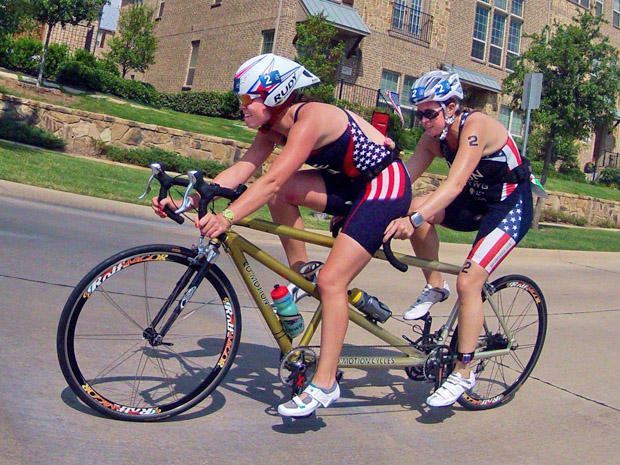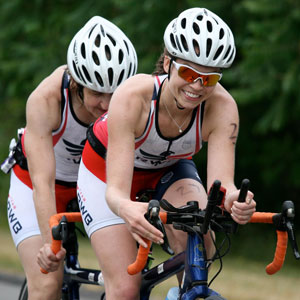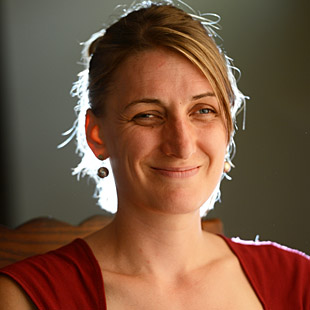A blind sommelier – and triathlete
Two years ago, Amy Dixon was in a down spiral after a series of eye operations to stem a rapid decline in her already reduced vision left her 45 pounds overweight, lacking motivation and understandably depressed. Refusing to be discouraged by a broken foot, she embarked on an exercise regimen that included water running and spin cycling that whittled away the weight and led her to a fortuitous meeting with Team Red, White and Blue guide Caroline Gaynor, who encouraged her to try a triathlon.
Since her introduction to triathlon a year ago, Dixon made remarkable progress just as the slender thread of her dimming eyesight has dwindled. Thanks in large part to Gaynor, Dixon competed in seven triathlons last year. This year, under the guidance of Greenwich [Connecticut] Elite Health Services coach Jon Stellwagen, Dixon finished 3rd in the PT5 category for blind triathletes at the PATCO Pan American Championships in Dallas and is hoping to qualify for the ITU World Championship in Edmonton this September.
Competing with a guide and traveling with her Guiding Eyes dog Elvis, Dixon has jumped at opportunities such as a Challenged Athletes Foundation training camp for Para-triathletes. She recently visited the USA Olympic Training Center in Colorado Springs to begin training with pilot Lindsey Cook to compete in the PT5 category at the USA Cycling Championship in July.
Her recent immersion in sport is remarkable. But Dixon’s tenacious journey from the onset of her eye disease at age 22 to her pursuit of triathlon began 16 years ago when she refused to surrender to onrushing blindness and began a career as a renowned wine expert and, for a time, continued her passion for equestrian competition.
Slowtwitch: Tell us about your parents.
Amy Dixon: I grew up in Westchester New York. My dad John Dixon worked in construction and he died when I was 22, at the same time I was diagnosed with my eye disease. My parents divorced when I was 6 or 7 and my mom did an amazing job raising two girls as a single mom. Originally she was a housekeeper, then started a wallpapering business in Westchester County and worked her butt off to put a roof over our heads and food on the table. Her work ethic was incredible. She turns 65 this year.
ST: What sports did you play?
Amy: I was a swimmer from age 6 through17, and I played soccer and tennis in high school. But my main interest was riding horses. I grew up on a horse farm and was riding before I could walk. I did three day eventing, which is similar to triathlon because it has three disciplines. The first phase is dressage, then cross country and third is stadium jumping. I trained for and competed in three day eventing and later coached students for this event. As it turns out, that served me well when I started cycling on the tandem bike in Paratriathlon. The pilots who ride up front like me because my equestrian background allows me to stay still and balanced on the tandem to provide the safest (and fastest) ride possible.
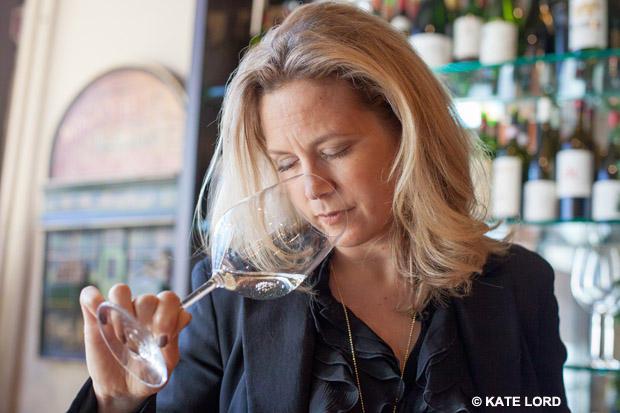
ST: Where did you go to college?
Amy: I was attending the University of Connecticut where I worked my way through school as a sommelier at night.
ST: How did you get interested in wines?
Amy: When I was in college, I traveled to Europe with my boyfriend to see his family in Germany and I fell in love with German wines and went on tours to Burgundy and to Alsace in France, not far from where his family lived. After that, I was passionate about wine.
ST: How did you make some money to help with college expenses?
Amy: I waited tables at the Greenwoods Grille in Bethel, Connecticut. The owner was a smart man. Many of his employees were starving college kids who had no money, so he ran contests every week where he offered a $25 bottle of wine to the person who sold the most that week. As a kid trying to keep a roof over my head and books in my book bag, I started to win ‘em all. Pretty soon he encouraged me to attend a school for wine and I got my certification as sommelier at the Wine and Spirits Education Trust at the International Wine Center in New York City.
ST: What was it like working as a sommelier in restaurants?
Amy: I worked at night and really enjoyed it. But it was hard. I had a difficult time seeing — the lighting was very low, we all wore dark uniforms with wintergreen shirts. I often could not see things in front of me and made some horrific mistakes. Once I walked around the corner and knocked over a tray of food. At the tables I would pour and miss the glass. At the time, I just thought I wasn't getting enough sleep and once midterms were over, I would get some rest and I would be fine. But things kept getting worse.
ST: It must have been challenging.
Amy: I was commuting an hour each way to school and working at night in my home town. I remember driving home on twisty, windy roads when the lights of an oncoming car blinded me — not just for a moment but for a long time after. It had a strobe effect and I felt woozy for a minute. I thought it was just a little vertigo. When I got home, I started typing a report and the flashing started again. I thought that was weird — but temporary.
ST: What led you to seek a diagnosis?
Amy: I was a college student and had no money and no health insurance. But I kept my annual checkup with a neurologist. I had been seeing him since I was 9 years old, and we caught up on my life as I was in my final year of a graduate program in pharmaceutical studies at the University of Connecticut.
ST: How did the examination go?
Amy: He was happy to hear about my life. But as I was talking to him, he held his hand up and asked how many fingers? I said, “That’s funny. Your arm is missing.” He said, “Do not joke around kiddo.” I said, “Your hand is not even there.”
ST: What next?
Amy: I had adapted to my declining vision for quite a while and I didn’t notice it had dimmed. The doctor thought it might have been a detached retina. He asked, “Have you had a blow to the head?” Three months prior, I suffered a concussion when one of the horses at the stable accidentally clocked me in the head. The doctor said, “That was a little bit too long ago. It shouldn’t be happening now. You need to see an ophthalmologist.” Knowing I would ignore him otherwise, he canceled his afternoon appointments and marched me like a 10-year-old to the ophthalmologist and sat with me to make sure I would not bolt.
ST: What was the diagnosis?
Amy: The ophthalmologist called a doctor in New York City who came to see me a few days later. That doctor took one look and said I had a rare eye disease. The medical encyclopedia stated it was multi focal choroiditis. It was described in formidably academic terms: An idiopathic inflammatory disorder of unknown etiology affecting the choroid, retina, and vitreous of the eye that presents asymmetrically, most often in young myopic women. He was blunt. He said I had this disease and there was no treatment and I will lose my vision in from one to 10 years.
DENIAL, ACCEPTANCE, ACTION
Amy: I called him not a nice word and stormed out of the office and called my boyfriend: “Those quacks! They say I have a rare disease — and I am going blind!” I thought I would just continue — until I fell down the stairs at my boyfriend’s and broke some ribs. I hadn’t seen the dog sleeping at the top of the stairs. I continually broke water glasses and bumped into things. My friends called me Gracie, because I was so darn graceful.
Finally, I went to a really sweet older doctor I was comfortable talking to. He said I could not ignore this anymore and contacted a doctor in New York City who discovered the disease. I charged my student union credit card and saw the specialist. He put me on high dose of steroids and said it might keep it in remission. He said, “We can't turn back the clock, but we can keep the blindness from getting worse.”
ST: How did your life change?
Amy: At that time, my dad died. And the school made it very clear that I could not be a blind pharmacist. I asked the dean what degree did I have enough credits to finish and he told me to look into equine business management.
ST: What other resources did you have?
Amy: I talked to my boyfriend and mentioned that I missed riding horses. Dad had a horse, and he left it to me. Maybe this could be my new career? I also knew there is no money in training horses, so I wondered: Should it be wine? So I got a new major in equine business management and began training horses and competing again.
ADVENTURES OF A BLIND SOMMELIER
Dixon continued to work in the wine business, but she couldn’t see to drive very well. So she quit the restaurant and started working at a wine store near where she lived in Danbury, Connecticut. Dixon’s involvement in a wine-related charity caught the attention of Theresa (Terry) Rogers, who offered her a job as a wine specialist at Horseneck Wine and Liquors in Greenwich. Taking Dixon under her wing, Rogers tutored her protégé in the great Bordeaux, Burgundy and Champagnes she never could have afforded while working at a restaurant. Like her first wine boss, Rogers invited her staff to taste and learn about any wine in the store under $200 and bring it to dinner — as long as they could sell a bottle of the wine the next week. No problem for Amy.
Dixon was an excellent saleswoman and was hired as a sales manager for Boisset America in 2003. At a client lunch, Seagrams Chateau and Estates national sales rep Tad Holtsinger invited Dixon to share a bottle of Chateau Ducru Beaucaillou 1982. Her intense memory of that experience explains a lot about her passion for wine: “It was perfumed, such a ripe plum, almost like a boysenberry aroma to it,” recalls Dixon. “It had a distinctive, wonderful intoxicating woody aroma, the essence of the oak. I thought, ‘Wow! I had never experienced anything like it before!’”
She performed well for Boisset, but once again she was faced with night driving. “I had one third of my vision left and was legal to drive, but I’d come up with excuses not to travel or I’d sleep on friends’ couches after dinners,” recalled Dixon.
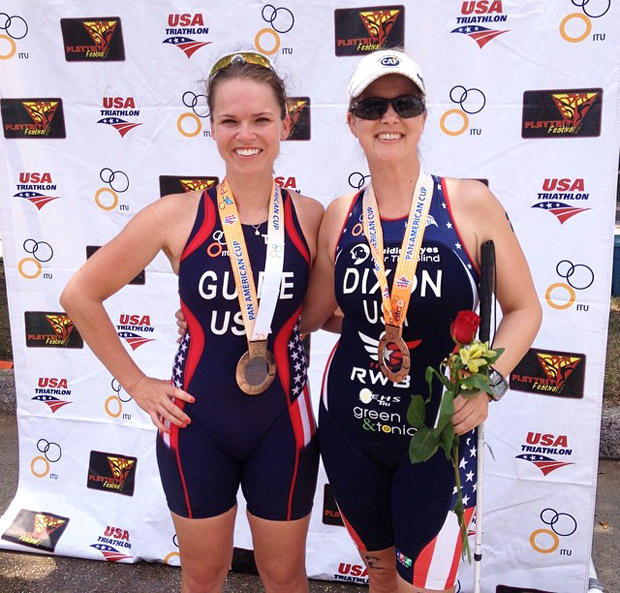
While she scaled back driving, she held on to her love of riding. On her days off, she taught horse riding and competed. “Those competitions were in a controlled environment, because three day eventing was an individual sport, so I did not worry about other people cutting me off or getting in my way,” she recalls. “You are on a horse and there are no other competitors on the course — unless a deer runs out at me in the cross country segment.”
But then came the exception.
She went to Florida to compete at a three day eventing in Ocala. “I was in the open division which had several elite riders,” she said. “As I was warming up, I cut off Olympic rider Karen O’Connor really badly and crashed into her. She tipped her hat at me and smiled and went on her way. Finally she walked over to my coach and asked him to say something to me: “She seems to be getting in the way…”
Dixon retreated to another warm-up area. “I was embarrassed and did not want people to know about my eyes,” she said. “That was my ‘Aha!’ moment when I knew I could not continue with this.”
After more scary incidents driving at night, she took an offer to work as a fine wine buyer at the Stew Leonard stores in Connecticut. “I had a lot of fun selling some really interesting wines,” recalled Dixon. “But I left four years ago because I was having so many eye surgeries and I needed time off to recover.”
THE ROAD TO TRIATHLON
ST: What did all this do to your physical fitness?
Amy: Because of the chemotherapy during treatment, I had an anaphylactic reaction to the steroid drugs which shut down my adrenal glands and gained a lot of weight. But my vision stabilized and I was grateful for that. In spring of 2012, I was itching to get back to exercise, so I asked my surgeon if he would allow me to start running outdoors.
ST: When did you start?
Amy: It was pouring rain at 5:45 PM Tuesday, May 8, 2012. I was so excited I had permission to start running again, my guide dog Elvis and I started to run a mile up the street to the Greenwich Running Company. I thought, 'Oh my gosh!' I don’t know if I can do a 15 minute mile to get there before it closes!’ I got to the door with a minute to spare soaking wet and out of breath. I said, “Hi! I want to run. Is there a group I could join and maybe follow you guys? I am blind but you can yell at me and let me know where you are going.” The guy shook his head and laughed. “Oh I guess so. Yeah, we go out Wednesday nights.”
I was excited and laughing as he walked me to the door. When I looked over my shoulder to wave good night, I fell down the stairs. I thought, ‘God must be telling me I was not meant to be a runner.’ I went to the emergency room and was in a cast for nine weeks.
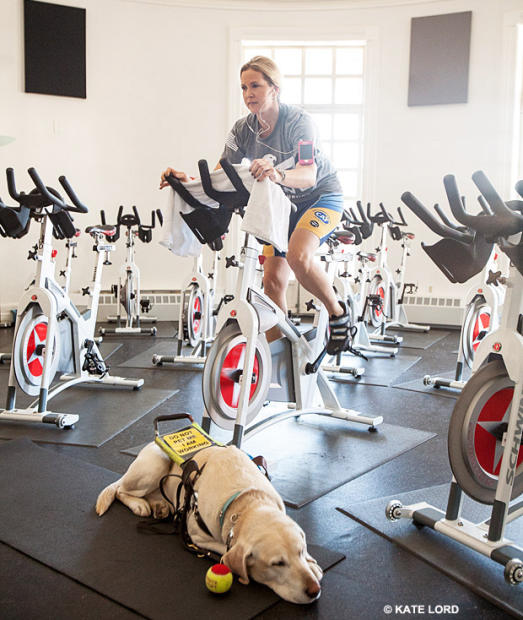
ST: When did you return to exercise?
Amy: My doctor said, “You can go in the pool in a removable boot, and you can aqua jog whenever you want.” The minute I got the boot I went across the street to the YMCA and the next few weeks I lost 15 pounds aqua jogging. As soon as my eye surgeon cleared me to put my face in the water, I began to swim in the pool. I would also sneak up the stairs to the spin room when no one was there.
ST: So how did you progress?
Amy: By August I was working out regularly on a spin bike. But I waited until late November before doing a little running on the treadmill.
ST: Why did you wait?
Amy: I developed plantar fasciitis, which hurt worse and took longer to heal than a break. All soft tissue injuries take longer to heal — especially because I put on 50 pounds.
ST: What led you to more ambitious activity?
Amy: At this time I did a Spin-a-Thon for charity in Danbury, Connecticut, where I met an amazing woman who guided visually impaired athletes in races — Caroline Gaynor. Caroline said, “Hey, you should think about doing a triathlon.” That appealed to me. I did one when I was 17 in Block Island, Rhode Island and loved it. But I didn’t think I was ready. I said, “Being old and fat and blind is not conducive to doing a triathlon.” She didn’t buy that sort of thinking and said, “There is no reason you can't do one now” and offered to guide me in a spring triathlon. Considering I had lost 30 pounds, I felt brave enough to try it.
ST: How can visually impaired athletes and guides get together?
Amy: Caroline Gaynor is Triathlon Director with Team Red White and Blue, who work primarily with wounded military veterans. Caroline is a wonderful resource for blind and disabled athletes who want to race with a guide. Guides put messages out there on a special Facebook group for blind athletes called Visually Impaired Runners and Guides and another one called Running Eyes.
ST: How much does she work with disabled athletes?
Amy: She has guided more blind athletes than anyone in the U.S. and at least four blind competitors in Ironman. She also helps blind people at Worlds and Nationals.
ST: How strong do the guides have to be?
Amy: You have to be able to run at least a minute per mile faster than the athlete they are guiding because you have to be able to talk the entire time.
ST: What was your next step?
Amy: Caroline invited me to the Tri-Mania Expo in February 2013 at the athletic complex at Columbia University. When I got there they asked me to participate in a swim clinic for disabled athletes run by USAT Paratriathlon.
ST: What helped you most in overcoming your insecurity about the triathlon?
Amy: At Tri-Mania I met an amputee Army vet and another nice young guy who had a stroke causing paralysis on one side of his body. I thought, ‘Oh my gosh! He is immobilized — I have no excuse.’
ST: How did you prepare for your first triathlon?
Amy: I realized one piece of equipment would be tough to get — a tandem bike. At Tri-Mania I met Eric Averill, the former head of USA Paratriathlon, who lives in Massachusetts. He said, “I may have an old one that sits in my garage. It is a dinosaur but it works and you are welcome to it.” Two weeks later he dropped it off. It was in beautiful condition, but it was made of steel, weighed 50 pounds and was an absolute beast. I thought, ‘Great!’ Only one more challenge — it was too big for most females. Caroline arranged a day in the spring to do a few rides prior to our race. Divine intervention arrived in the person of Ray Kelly, who is very active in the Challenged Athletes Foundation and who organizes the Sleepy Hollow Sprint I was going to race. I was so nervous, I blew up his emails and phone with a dozen silly questions. He must have thought I was a nut case. But Ray just said, “Don’t worry, it will be great!”
ST: What worried you the most?
Amy: The swim. I had never been with a whole bunch of swimmers around me, clobbering me and hitting me and I had no peripheral vision to see a fist coming at my face. But Caroline had been a former water polo player so I knew I would be safe in the water.
ST: How did the race go?
Amy: When I discovered we were in the last swim wave, I was mortified. All the people had to stick around to watch this one blind girl starting all by herself. But I had such a good swim, I caught and passed some people in the previous wave – Yay!
ST: What did you feel when you finished?
Amy: It was the most incredible experience. I had every problem you can imagine. They ran out of water on the course. My chain fell off the bike. The run portion started on grass that was criss-crossed with giant tree roots and I kept tripping, so Caroline held me up by my elbow. I thought she must think this was ridiculous. But I had the best time and Ray Kelly gave us a special award.

ST: Triathlons require a lot of equipment. Did you do any simple running?
Amy: While preparing for my first triathlon, we were running with a group from Achilles International, a group of disabled athletes who ran and competed locally. We did the Achilles Hope and Possibility race and Gloria Gaynor, who sang the famous song, ‘I Will Survive,’ sang the anthem honoring the Boston Marathon bombing victims.
ST: You met Caroline Gaynor, then Gloria Gaynor? Coincidence?
Amy: We were so excited and we all ran like little kids to meet Gloria after the race.
ST: Was it easier the next time?
Amy: The next race in Sharon, Connecticut I finished first in the swim even though I got clobbered in the water. When I got in the water I could not see, could not hear – only feel. People swim on top of you and you can't see them. It was very unsettling. At that time, my left eye was 20-20 while my vision with my right eye was as if I were looking through a pinhole.
ST: Were you reluctant to do another triathlon?
Amy: At that time I was going to take a vacation to Block Island with my family and I thought I ought to do the triathlon there. I heard no guides were available, so I spoke to the manager at a local sports shop. He contacted the local triathlon club and found a nice husband and wife. In that race, anything goes, so we decided to tag team it — the husband agreed to swim and bike with me and the wife agreed to guide the run.
ST: How did it go?
Amy: We had a great time even though it was the most treacherous race to date. We swam over rocks, and fought ridiculously high waves. I got bloody ankles running on the beach and sand in my shoes which got soaked and must have weighed 20 waterlogged pounds. It took a while to recover from my ankle cuts and bruises but it was a blast.
ST: How many races did you do that year?
Amy: After Block Island, I signed up for the New York City Olympic distance in mid-July. Caroline wasn't available, so she booked a wonderful guide from who flew out from Colorado. Deedee Johnson was a professional mountain biker and it was her first time triathlon. The run was torture — it was so hot in Central Park. I had never run 6 miles before but I survived. We had a great finish in a time of 3:06 and I ended up in second place in the visually impaired category. That year I did seven races through October and I signed up for a Challenged Athletes Foundation triathlon training camp in August of 2013.
.
ST: Have you met blind triathlete Patricia Walsh?
Amy: Patricia Walsh is on the USA Triathlon Elite Paratriathlon team. I am so lucky she was my mentor at camp for Challenged Athletes Foundation in San Diego last August.
ST: How did the Challenged Athletes Foundation camp help you?
Amy: I flew out to San Diego to learn from Mark Sortino, who is the national coach for the USA Triathlon Paratriathlon Team. There I began a full immersion swim and bike and run camp. I learned different techniques for every discipline and I learned the specific rules for Paratriathlon. We had seminars, classroom instruction and a run clinic. Mike Jennings, a very nice master cycling champion donated his time and served as my pilot throughout the camp.
ST: What was the highlight of the camp?
Amy: On the last day we did a duathlon. I was psyched. I had a really strong pilot on the bike and a good guide in the run. The swim and bike are my strong suits, but I am not a good runner. So I was bombing along running 9 minute miles when I heard two ladies chatting and coming on fast. I thought, ‘It’s Patricia!’ It was a wonderful sight when she trotted by me at 6:30 per mile pace. Even with my very limited sight, she looks like a deer!
ST: What are your goals in triathlon now?
Amy: I will race the New York City Triathlon and Colonel Patty Collins will be my guide. I also hope to qualify for and race the ITU Paratriathlon World Championship in Edmonton at the end of August. Then I will race again at the Mid-Atlantic regionals in Atlantic City in September. On October 6, I will do my first Half Ironman in Austin, Texas.
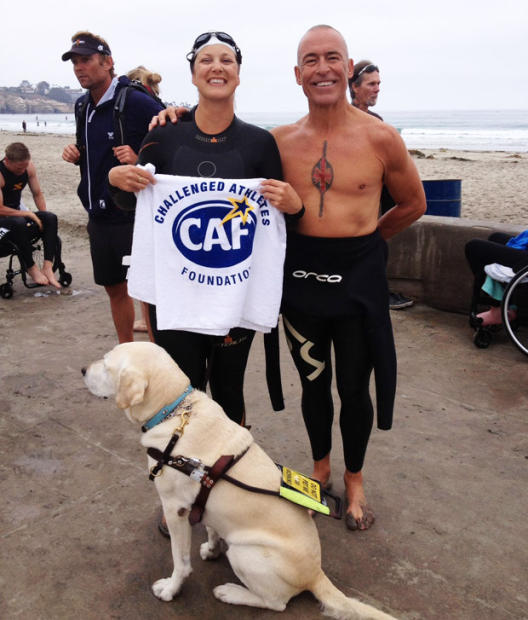
ST: Due to your blindness, you have met a special friend. Tell us about your guide dog Elvis?
Amy: Elvis is really amazing. I should have made the decision years ago to get a guide dog. I needed help, but I was reluctant to relinquish control of my independence to a creature with four legs that has an opinion. I have trained 1,200-pound horses but never worked with an animal and given it that much responsibility. It took a while to learn to trust him.
ST: How much does it cost to train a guide dog?
Amy: It costs Guiding Eyes for the Blind in Yorktown, New York approximately $50,000 to train the dog and to teach the blind person how to work with the dog. Thanks to donations, blind persons do not pay.
ST: What is it like to partner with a charismatic dog?
Amy: Elvis is a celebrity. We cannot walk around town without making the rounds of his fans. If we walk past the Health Mart food store and I do not stop to get Elvis a treat, Elvis gets mad and the owner teases me. They have organic dog treats from Colorado and Elvis is obsessed with them.
ST: Where else do you take Elvis?
Amy: Elvis comes to every single spin class and workout and he comes to the pool with me three times a week. He sits on a yoga mat and we put his leash around some lane markers and he watches me go back and forth for an hour. He is very, very good around the water at the pool. But outdoors, all bets are off.
ST: What happens with Elvis at outdoor pools?
Amy: I took a trip to Austin, Texas and had an opportunity to swim at a giant outdoor limestone quarry which had a dock and swim buoys. I was with a Navy veteran who was helping me and I had a friend hold Elvis on the dock. The water was really warm — 87 degrees. Consequently when we got to the first buoy I was tired and stopped. Suddenly, there was my dog! My friend could not hold him any longer. Elvis just wanted to join in and kept swimming around us. He had a jealous look on his face which seemed to be telling me: ‘I can guide you!’
ST: Does Elvis have a sense of humor?
Amy: On a trip to Antigua where I represented the World Glaucoma Patient Association, Elvis had some moments. He knows I am totally blind in my right eye so he tiptoes up and sneaks to my right side and licks my face. Then he hops up and down, enjoying his trick as if to say, ‘I caught her! I caught her!’ On the beach in Antigua I was reading a book on tape, so I tried to stop him from fetching and get some rest for a. moment. Out of nowhere, he dropped a coconut on my back, basically telling me, ‘Hey mom! It’s a ball!’
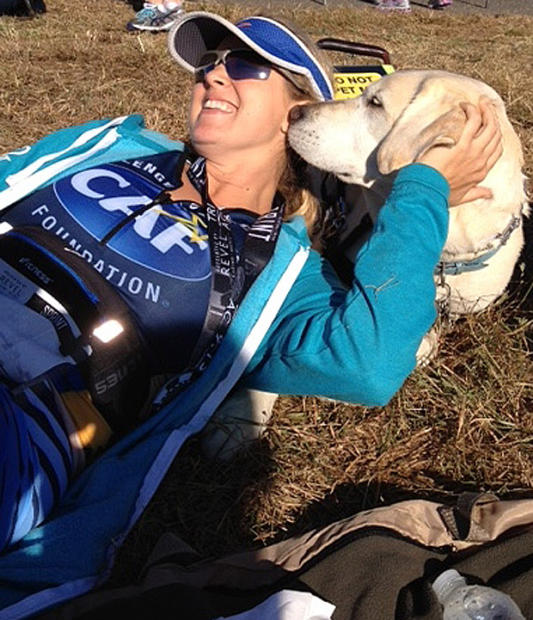
ST: What is happening with your career in wine?
Amy: I am looking to open a wine bar in Connecticut. But I recently had several surgeries, so a lot of my plans have been sidetracked due to recovery and complications.
ST: What new problems have developed?
Amy: I developed glaucoma, due to a chronic inflammation from scar tissue. The inflammation affects pressure inside my eye, which builds up after the glaucoma emergency surgery two years ago. The recovery process precipitated another weight gain while my right eye stabilized. From September to February this year, doctors performed seven procedures on my failing eyesight. I was in and out of hospitals with no guarantees doctors could save what little vision remained.
ST: How much has your sight deteriorated?
Amy: In the past I had decent sight in my left eye. But right before the Atlantic City triathlon last summer, the pressure skyrocketed and I had emergency surgery to lower the pressure. The condition is called hypotony where the eye is like a deflated basketball. Because there is a hole in it, I cannot keep my eye stable. When pressure drops, fluid leaks out and the retina can detach.
ST: What did your doctors tell you about continuing with triathlon?
Amy: The biggest concern is being in open water. The doctor said, ‘You’ve got open stitches in your eye. Your eye is so delicate right now, we don’t want you putting goggles on your face.”
ST: How careful must you be?
Amy: The pressure has improved. But it could all collapse at any time. It’s a fine line that I walk. Worrying about it won’t make it any better.
ST: Do you consider yourself handicapped?
Amy: My visual impairment is NOT a handicap. It has caused me to be in tune with my other senses and even more with my surroundings and other people. In some ways, it has been a gift.
Amy Dixon is entirely self-funding her racing schedule despite not being able to work full-time due to her multiple eye surgeries. To help support her efforts to buy her own tandem racing bike (she currently rides a borrowed one) and airfare, bike shipping, entry fees and hotels for Amy and her guide, contact this link:
https://usaba.myetap.org/fundraiser/athletedevelopmentaccounts/individual.do?etapCacheBuster=1399865747593&participationRef=849.0.453599289&shareMedium=label.facebook
